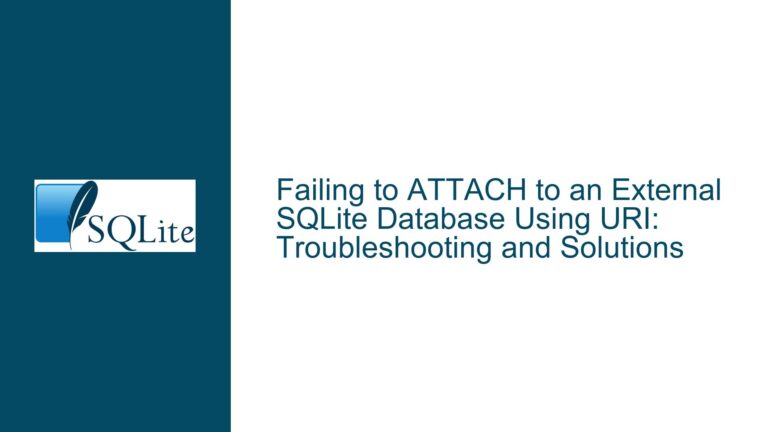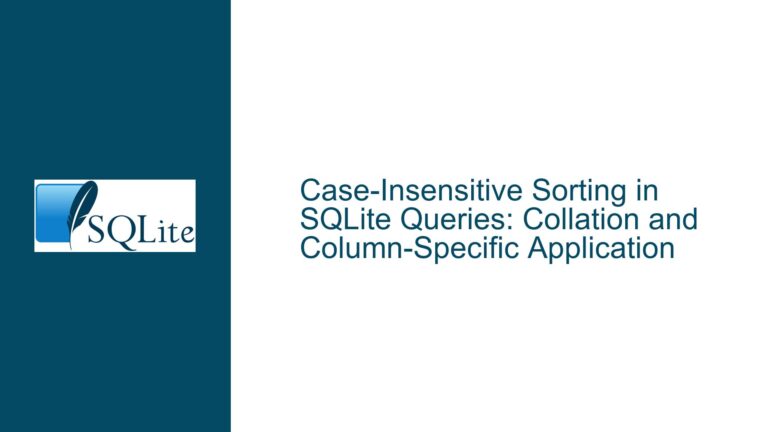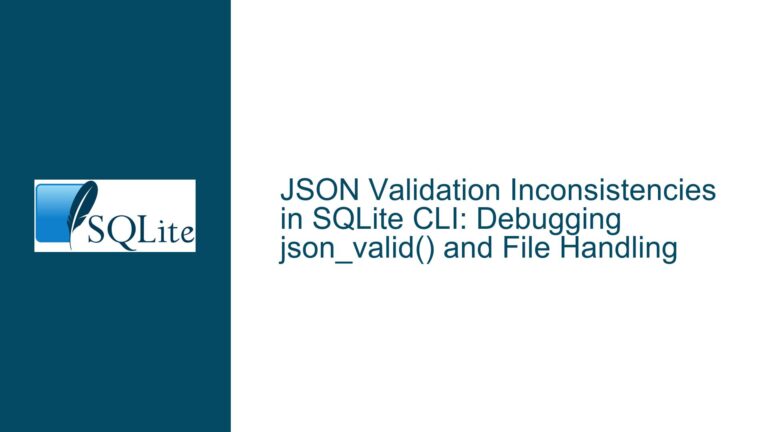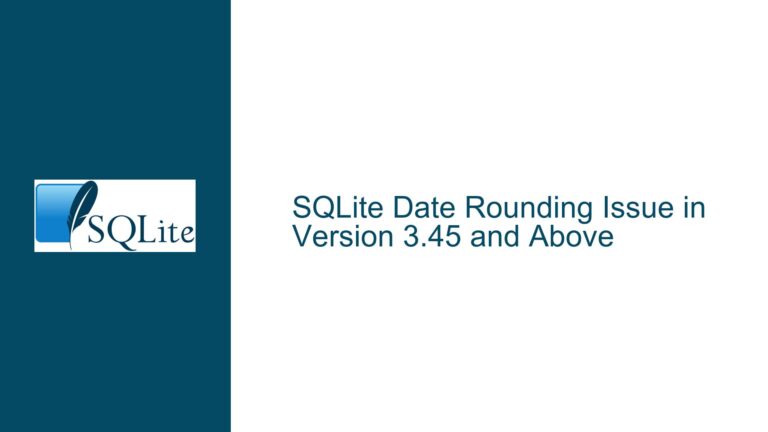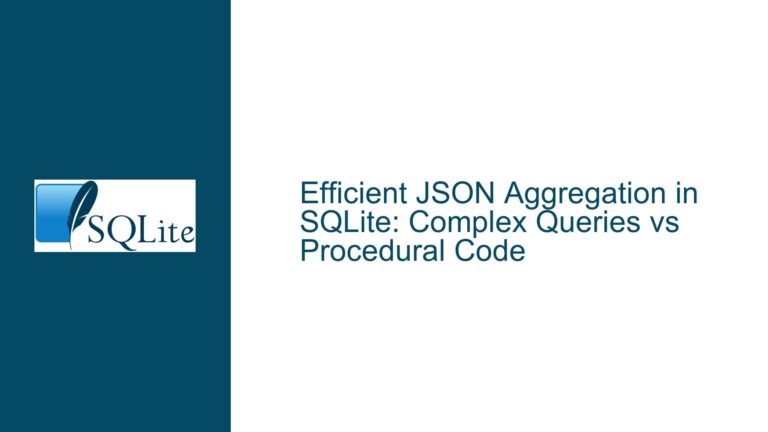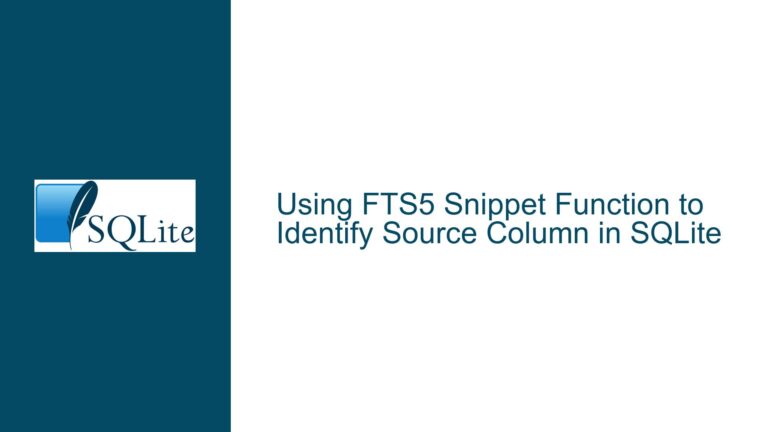Using COALESCE in WHERE Clause Yields Unexpected Results in SQLite
Unexpected Behavior with COALESCE in WHERE Clause
When working with SQLite, a common scenario involves merging data from two tables, where one table contains base data and the other contains updates. The COALESCE function is often used to handle NULL values, ensuring that the query returns a non-null value from either the base table or the updates table. However, in this specific case, the use of COALESCE in the WHERE clause is not yielding the expected results. The query returns no rows when filtering on a column that has been coalesced, even though the same coalesced value appears to be correctly calculated in the SELECT clause.
The query in question is structured as follows:
SELECT COALESCE(b.col1, a.col1) AS var, a.col3
FROM a
LEFT JOIN b
ON COALESCE(a.col1, 'X') = COALESCE(b.col1, 'X')
AND a.col3 = b.col3
WHERE COALESCE(b.col1, a.col1) = 7;
The issue arises when the WHERE clause is applied. Despite the fact that the SELECT clause correctly returns rows where var is 7, the WHERE clause fails to filter these rows, resulting in an empty result set. This behavior is unexpected and suggests that there may be underlying issues with how SQLite handles COALESCE in the WHERE clause, or perhaps with the data types of the columns involved.
Data Type Mismatch and Manifest Typing in SQLite
One of the primary reasons for this unexpected behavior could be related to SQLite’s manifest typing system. Unlike other databases that enforce strict data types, SQLite allows any column to store any type of data, regardless of the declared column type. This means that a column declared as CHAR or TEXT can store numeric values, and vice versa. This flexibility can lead to subtle issues when comparing values, especially when using functions like COALESCE.
In the given query, the column col1 is declared as CHAR, but the actual data stored in the column could be of any type. If col1 contains numeric values, the comparison in the WHERE clause (COALESCE(b.col1, a.col1) = 7) might fail because SQLite is treating the values as strings rather than numbers. This is particularly problematic when using COALESCE, as the function returns the first non-null value, but does not perform any type conversion.
To further complicate matters, SQLite’s type affinity rules can influence how values are compared. For example, if col1 has a TEXT affinity, SQLite will attempt to convert the right-hand side of the comparison (7) to a string before performing the comparison. This can lead to unexpected results if the data in col1 is not consistently stored as strings.
Another potential issue is the use of the IS operator in the ON clause. While IS is a valid operator for comparing NULL values, it is not the same as the equality operator (=). The IS operator is specifically designed to handle NULL comparisons, and it returns TRUE only if both operands are NULL. In contrast, the equality operator (=) returns NULL if either operand is NULL. This subtle difference can affect the results of the join, especially if col1 contains NULL values.
Diagnosing and Resolving COALESCE Issues in SQLite
To diagnose and resolve the issue with COALESCE in the WHERE clause, it is essential to first understand the data types and values stored in the columns involved. One approach is to inspect the actual data types of the values in col1 using the typeof function:
SELECT typeof(col1) FROM a;
SELECT typeof(col1) FROM b;
This will reveal whether the values in col1 are stored as integers, strings, or some other type. If the values are stored as strings, the comparison in the WHERE clause will need to account for this by converting the values to the appropriate type. For example, if col1 contains numeric values stored as strings, the CAST function can be used to convert the values to integers:
WHERE CAST(COALESCE(b.col1, a.col1) AS INTEGER) = 7;
Alternatively, if the values in col1 are consistently stored as strings, the comparison in the WHERE clause should be performed using string literals:
WHERE COALESCE(b.col1, a.col1) = '7';
Another approach is to ensure that the data types of the columns are consistent across both tables. This can be achieved by explicitly casting the values to the desired type when inserting or updating the data. For example, if col1 should always contain integers, the following INSERT statement can be used:
INSERT INTO a (col1, col3) VALUES (CAST(? AS INTEGER), ?);
In addition to addressing data type issues, it is also important to consider the use of the IS operator in the ON clause. If the goal is to match NULL values, the IS operator is appropriate. However, if the goal is to match non-null values, the equality operator (=) should be used instead. For example:
ON a.col1 = b.col1
AND a.col3 = b.col3;
Finally, if the issue persists, it may be helpful to examine the Virtual Database Engine (VDBE) code generated by SQLite for the query. The VDBE code provides a low-level view of how SQLite executes the query, and it can reveal potential issues with how the query is being processed. The VDBE code can be generated using the EXPLAIN command:
EXPLAIN QUERY PLAN
SELECT COALESCE(b.col1, a.col1) AS var, a.col3
FROM a
LEFT JOIN b
ON COALESCE(a.col1, 'X') = COALESCE(b.col1, 'X')
AND a.col3 = b.col3
WHERE COALESCE(b.col1, a.col1) = 7;
By carefully analyzing the VDBE code, it may be possible to identify specific steps in the query execution that are causing the unexpected behavior. For example, the VDBE code might reveal that SQLite is performing a type conversion at an unexpected point in the query, leading to incorrect results.
In conclusion, the unexpected behavior with COALESCE in the WHERE clause is likely due to a combination of data type mismatches and SQLite’s manifest typing system. By carefully inspecting the data types of the columns involved, ensuring consistent data types across tables, and using appropriate type conversion functions, it is possible to resolve the issue and achieve the desired query results. Additionally, examining the VDBE code can provide further insights into how SQLite is processing the query, helping to identify and address any underlying issues.

